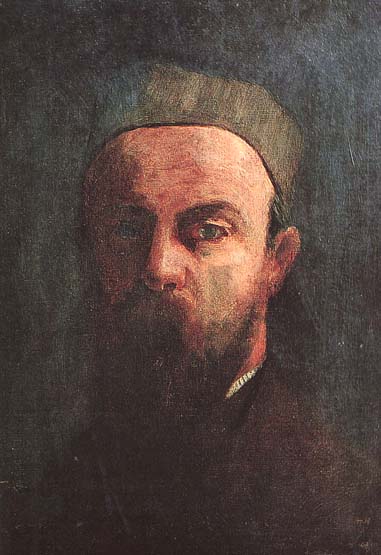
LIFE AS MYTH
![]()
JOURNAL
![]()
JOURNAL 2008
![]()
Impressions at sunrise
Finding the inner muse
![]()
AUTUMN 2008
Portraits of self
![]()
LIFEWORKS
![]()
ATLAS
![]()

AUTUMN 2008
ODILON REDON 1880
My originality consists in putting the logic of the visible to the service of the invisible.
Odilon Redon (1840-1916)Odilon Redon was one of the outstanding artists of the Symbolism movement, a multi-disciplinary arts movement, most active in the late nineteenth century, which rejected naturalism and realism in favor of spirituality, the imagination and dreams. Born April 22, 1840, Redon was the second son of a successful French businessman who lived in the United States. His mother, also of French descent, was from New Orleans. Because he was a sickly child (possibly with epilepsy), his parents sent him to live with a caretaker on the family estate in Peyrelebade. His childhood was spent apart from his parents and, as a result, in his later life he struggled with issues of parental abandonment.
From an early age, Redon showed a facility for drawing and began formal training in 1855. His father directed him away from the pursuit of art and into the study of architecture. However, when Redon failed his examinations, any chance of a career in architecture ended. He then returned to the fine arts, studying sculpture, etching and lithography.
The canon of his work presents in two distinctly different forms. The first half, until roughly the mid-1890's, is comprised of charcoals and lithographs. These pieces explored unusual and often grotesque subjects (e.g. plants with human heads). Redon was a private man and his work during this period remained relatively unknown until the publishing of J. K. Huysmans's novel À rebours (Against Nature) in 1884. The book's decadent hero collected Redon drawings and this mention brought considerable recognition and attention.
From 1886-1895, events in Redon's life laid the groundwork for the transformation of both the artist and his art. He and Camille Falte, his wife, had their first child, Jean, in May 1886. When Jean died the following November, the acutely sensitive and artistic Redon entered a prolonged period of depression and spiritual crisis. His melancholy further deepened during a serious illness in the mid-1890's. Motifs during this period included floating eyes, decapitated heads and shackled angels.
Navigating through a period of personal crisis between 1886 and 1895, Redon's art moved from a darkly-themed world of charcoals and lithographs to a mysterious world of brilliantly hued pastels and oils. In this next half of his artistic life, he still explored his extraordinary visions but his attitude toward them had radically changed. His previously morose view of life, anchored in some way perhaps to his solitary childhood, transformed into a more joyful one and this happier maturity translated on to the canvas. His artwork during this ten year period provides an intimate window into his healing, as he moves from macabre-themed charcoal sketches to mythological and floral works bathed in luminous color. Though unhappy for most of his life up to that time, the illness transformed him into a more joyful and optimistic person. Some art historians credit the birth of his second son Ari in 1889 as being an important factor in Redon's eventual recovery.
The maturing of artistic work often falls within the thematic parameters of alterswerk. Alterswerk, literally latter works, refers to the final output of an artist just prior to their death. The three characteristics of alterswerk -- interest in death, recapitulation, and prophetic visions -- not only occur toward the end of an oeuvre but they also accompany the final psychological stages of life. The artworks by Redon which fall after 1905 best fit this category of alterswerk. During this period his use of color reached its zenith as he repeatedly explored spiritual and mythological motifs, such as the Buddha, the birth of Venus, Apollo's Chariot, and the death of Ophelia -- as well as a series of butterflies, flowers and boats.
The legendary International Exhibition of Modern Art, also known as The Armory Show of 1913, introduced United States art patrons to Modern Art. From February 17 - March 15, the 69th Regiment Armory in New York featured 1250 avant-garde artworks, representing over 300 European and American artists. Thirty-eight of Redon's paintings and lithographs were featured in galleries J and K of the exhibition, making his work one of the centerpieces of the event. He met with significant critical and financial success, most notably due to the purchases of Lillie P. Bliss.
Bliss was an American art patron who inherited a sizeable fortune following the death of her father in 1912. She was instrumental in organizing the Armory Show of 1913 and was one of the earliest collectors of modern paintings. Redon artwork that she purchased during the exhibition includes: Pegasus Captive (1889), Petit Prélat (1889), The Light of Day (Le Jour)/Plate VI from Songes (1891), Druidesse (1892), L'Aile (1893), Silence (1911), Roger and Angelica (1912).
In the last three years of Redon's life there were several significant events. To begin with, there was the Armory Show of 1913 which introduced American art patrons to Redon. He was not only the most represented artist in the exhibition but one of the most financially and critically successful as well. That same year, André Mellerio published a catalogue of his lithographs. This recognition late in his life continued in 1915 with two more major exhibitions: one at the John Herron Art Institute of Indianapolis and the Second Exhibition of Contemporary French Art at the Caroll Gallery of New York. In his personal life the most significant event during this period was his son Ari's mobilization for war (1914). This development was the inspiration for Redon's painting The cyclops.
Redon remained a quiet and intensely private artist to the end of his life. He died in Paris on July 6, 1916. The virgin, his final oil on canvas, was left unfinished.Self-portrait. Odilon Redon. 1880. Musée D'Orsay, Paris.

